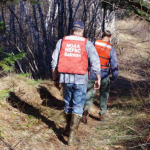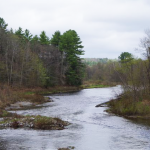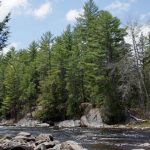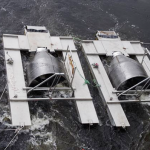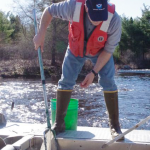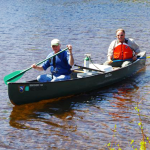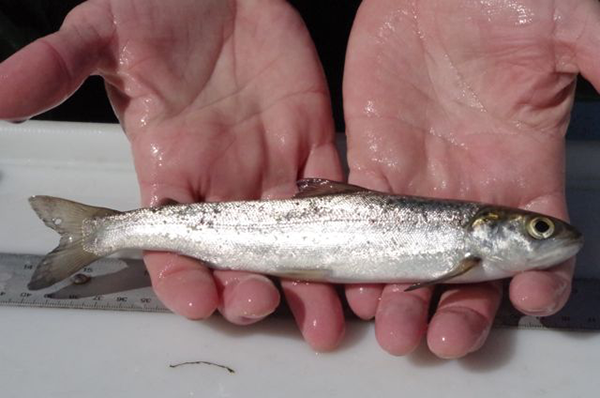
Counting smolts in May: a story of Atlantic salmon survival.
by Catherine Schmitt
May 16, 2014, Endangered Species Day.
I went to the Piscataquis River, a major tributary of the Penobscot River, to monitor Atlantic salmon (Salmo salar) smolts with state and federal fish biologists.
Shadbush and trout lilies bloomed along the stream banks. People sold fiddleheads from the trunks of their cars. Nearly 70 degrees, sunny, breezy. A big rain was headed to the region the next day.
Randy Spencer, of Maine Department of Marine Resources (DMR) Bureau of Sea-Run Fisheries & Habitat, caught 37 Atlantic salmon smolts the previous day, and expected more.
“How do they look?” asked John Kocik of NOAA Fisheries.
“They look a little bit light. Maybe they had a hard winter. The ice breaking up in January might have hurt,” said Spencer, who grew up in Hampden, Maine, a town on the lower Penobscot River.
Smolts are juvenile salmon moving from the freshwater riffles where they spent their youth to the ocean, where they will grow into adults. They are transitioning physiologically, as their gills prepare for salt water, their exterior takes on the silvery shine of a schooling ocean fish, and their shape and tail streamline for the long migration to Greenland. Smolts move at night, especially those that leave early in the season, so we were on the river in early morning. Redstarts and chestnut-sided warblers flittered in the bushes. Black flies were out, but barely.
- Fisheries biologists walk through the woods to the river.
- Piscataquis River near Abbot, Maine.
- Piscataquis River near Abbot, Maine.
- Rotary screw traps are floating devices that capture live fish in rivers for scientific assessment.
- John Kocik of NOAA fisheries removes fish from a trap with a net.
- Rich Langton and Randy Spencer paddle a canoe to shore to measure fish.
Smolts are products of their freshwater habitat, and thus tell the biologists something about whether or not the river is as good a home for salmon as it once was. To get the message, the biologists have to catch the smolts, mark and measure and count them, before letting them go. They accomplish this with a “rotary screw trap”: a rotating metal cone mounted to a floating platform. Maine was the first state east of the Mississippi to use rotary screw traps. Kocik had learned about them at an American Fisheries Society meeting Oregon, and partnered with DMR to bring a couple to the Narraguagus River in 1996, where he showed they could work (and still do). The smolt trapping has since expanded from the Narraguagus to the Penobscot and other rivers. The method allows biologists to sample the entire population of a river in one location. The wide end of the “screw” faces upstream. Water flows in and spirals through the threaded inside, directing any fish toward the narrow end, and into a hold.
Kocik, Spencer, and Rich Langton (also of NOAA Fisheries) paddled out to the traps, located in a stretch of quickwater where rock ledges pinch the channel. They removed fish with long-handled dip nets, documented and returned fish other than salmon (suckers, trout, minnows) to the river, and put the salmon in buckets and coolers for transport to land, where the fish were sampled for length, weight, smolt stage, fin condition, and marked with a tiny notch in the tail. They were trying to get a sense of how many leave the river and eventually return, and what might make some smolts more successful than others.
“The end point that we want is adult returns, and wild smolt production,” said Spencer. “This tells us if what we are doing is working.”
What they are doing is trying to restore an endangered species. How they do it is a bit more complicated.
People have been moving fish around the Penobscot River watershed for more than a century. The hatchery at Craig Brook was started by Charles Atkins in 1871 to address declining populations of native, wild Atlantic salmon. By then salmon had been lost from most of New England’s rivers, and numbers had declined in the Penobscot, due to both logging and related dam-building in the upper watershed and commercial fishing in the estuary. In the early days of salmon restoration, Penobscot River salmon went everywhere. Fish were moved around willy-nilly. Yet despite all this manipulation, genetic remnants persisted.
The U.S. Fish and Wildlife Service’s Craig Brook National Fish Hatchery continues to maintain salmon populations today, along with Green Lake National Fish Hatchery. Biologists have estimated that a minimum of 325 families/650 adult salmon are needed to preserve the genetic health of the species. When they reach the first dam (which used to be at Veazie but now is at Milford thanks to the Penobscot River Restoration Project), the first 650 adult salmon to return to the Penobscot (or all of the adults, in years when fewer than 650 return) are transferred to Craig Brook. They are kept there for the summer (avoiding the risky period of roaming around the river) until they are spawned (by human hands) in November. Some (one million) of the eggs are moved to Green Lake to grow into smolts (accomplished in one year versus two or three in the wild), and 500,000 of the larger smolts are put into the river the following spring. The smolts are stocked in the lower river so they pass as few dams as possible—over the last 40 years, dams have killed some six million hatchery smolts, worth about $18 million). The smolts spend a few months or weeks in freshwater and then migrate to sea. When they return as adults, they return to where they were stocked in the lower river, instead of the best spawning habitat in the upper reaches above the dams.
So even the returning adults are the progeny of stocked smolts, themselves the progeny of hatchery fish, and on and on for thirty generations. Almost all of the salmon in the Penobscot have hatchery origins. (Spencer: “The probability of a wild-wild cross is infinitesimal.”) John Kocik calls this “sea ranching,” because the fish are not undergoing natural selection in freshwater, and therefore have less wild river life experience to pass on to their offspring.
The Downeast rivers and the Sheepscot work the opposite way: those fish are collected as juveniles in freshwater and sent to Craig Brook for two or three years to grow into breeding adults, whose eggs are then stocked back into the rivers as fry. This “river ranching” process skips the marine phase.
“Both methods conserve families, and we can’t afford to lose families. But we need to maintain and increase genetic diversity,” said Kocik. “There is tension between not wanting to lose families and wanting natural selection to happen. Now, we can’t have natural selection because demographically they’d be doomed. Genetic diversity is what’s going to save these fish and make them resilient. The only way we can save so many families is with the hatchery, but the hatchery alters the fish. If we let selection happen, they’d go extinct [because there just aren’t enough fish]. If the genetics of these fish are ever going to survive, we have to do crazy stuff like this.”
Randy Spencer initiated a different (and still crazy?) approach that would allow fish to be influenced by both freshwater and saltwater (combining both “river ranching” and “sea ranching”). He wondered if salmon could still survive and reproduce on their own, without so much the human assistance. Ever faithful in his fish, Spencer took adult Penobscot salmon, which had the spent the summer at Craig Brook, and placed them in the upper Piscataquis in the fall, right when they were ready to spawn. The fish dug a redd, spawned, deposited eggs, and left the river. The next year, Spencer found baby salmon fry where the adults had nested.
The smolts that were trapped, counted, and tagged this spring are the progeny of those adults that were relocated by Randy Spencer, or perhaps the rare few that were passed upstream of the trap at Veazie and spawned naturally. The experiment will come full circle in another two years, when the smolts return as adults, and find their way through the Gulf of Maine, 125 miles up the Penobscot and Piscataquis, past Dover-Foxcroft and Guilford and Abbott, past five dams, to the same reach where they hatched.
Both NOAA and Maine DMR have been at this crazy game a long time. Spencer’s experiment is just the latest attempt in a continuing effort to restore Atlantic salmon, now an endangered species, but perhaps also a species whose chances of survival have never been better, thanks to people who spend their May mornings on the river, counting every fish.

